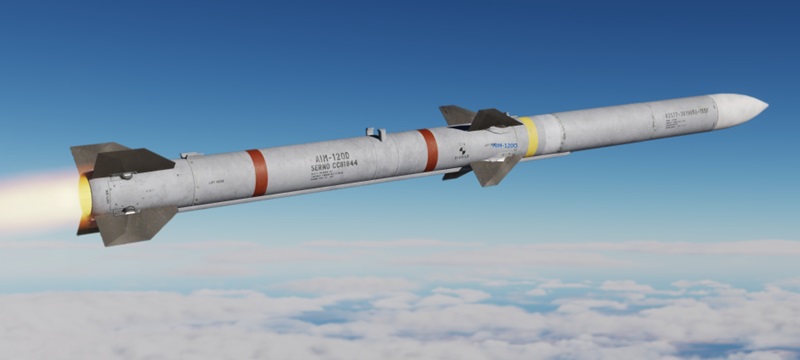
AMRAAM Missile
Raytheon AIM-120 AMRAAM Missile
Advanced Beyond Visual Range BVR Air-To-Air AIM-120 AMRAAM Missile By Raytheon
The AIM-120 AMRAAM missile is a combat-proven, radar-guided air-to-air Beyond Visual Range (BVR) missile system used by the US Armed Forces, NATO, and other international customers. The AMRAAM stands for Advanced Medium-Range Air-to-Air Missile.
The AIM-120 is an American beyond-visual-range air-to-air missile manufactured by Raytheon. It is a highly advanced air-superiority air combat BVR missile capable of all-weather day-and-night operations.
The AMRAAM missile is the world’s most combat proven and popular beyond-visual-range BVR missile, used as a primary weapon system for very long distances beyond visual range engagement.
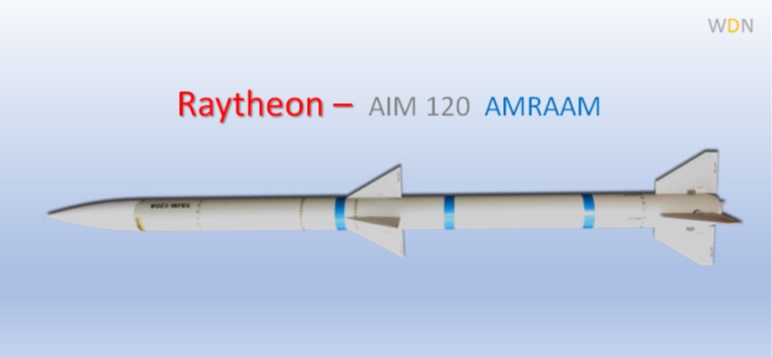
The AIM-120 Advanced Medium-Range Air-to-Air Missile (AMRAAM) is widely considered to be one of the best air-to-air missiles in the world. It is a versatile, all-weather missile designed to engage a wide range of targets, including enemy aircraft and cruise missiles, at beyond visual range.
The AMRAAM has been in service since 1991 and has undergone several upgrades, making it a highly capable and reliable weapon system. It is used by the United States and many of its allies, and has been exported to several other countries.
The AIM-120 AMRAAM is a highly capable and reliable weapon system that has proven itself in combat. Its combination of range, accuracy, and reliability make it one of the best air-to-air missiles in the world.
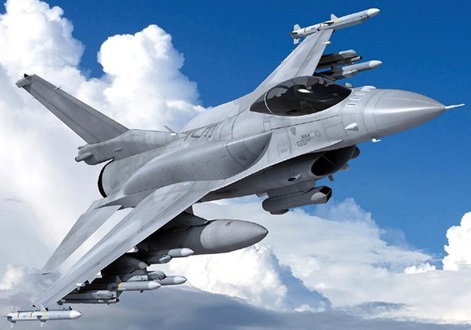
It is now in service with the US Air Force, the US Navy, and other international customers. For long-distance BVR engagements, it is regarded a highly effective weapon system against a wide spectrum of aerial targets such as UAVs and fighter jets.
Because of its combat record, the AMRAAM missile has earned a reputation. It is regarded as the gold standard in air-to-air weapon systems and provides unparalleled performance. Despite its modest size, the missile is packed with cutting-edge technology.
The AIM-120 is carried by a variety of fighter aircraft, including the F-15 Eagle, F-16 Fighting Falcon, F/A-18 Hornet, and F-22 Raptor. It has been used in several conflicts, including the Gulf War, the Kosovo War, and the Syrian Civil War.
Overall, the AIM-120 AMRAAM is a highly effective air-to-air missile that provides a critical capability for air forces around the world. Its long-range and advanced guidance system make it a formidable weapon against any air target.
AIM-120 AMRAAM Missile General Features
AIM-120 AMRAAM Missile | |
Missile Type | Air-To-Air BVR Missile |
Manufactured By | Raytheon |
Unit Weight | 157.8 kg , ( 348 lb ) |
Missile Length | 3.65 Meters , ( 12 ft 0 inch ) |
Missile Diameter | 17.8 cm , ( 7.0 inch ) |
Unit cost | $ 1.3 Million - AIM120 C5 $ 1.9 Million - AIM120 C8 |
Warhead | High Explosive Blast-Fragmentation |
Detonation Mechanism | Radar Guided - Impact |
Engine | Solid-Fuel Rocket Motor |
Operational Range | 80 Km To 160 Km |
No Escape Zone | 30 Km |
Guidance System | Inertial Guidance, Mid-course Update via Two-Way Datalink, Terminal Active Radar Homing |
Maximum Speed | Over Mach 4 |
How AMRAAM Missile Works ?
The AIM-120 AMRAAM (Advanced Medium-Range Air-to-Air Missile) is a highly sophisticated air-to-air missile designed to engage and destroy enemy aircraft and other targets at medium ranges. It is widely used by the United States Air Force and Navy, as well as by several allied nations.
The AIM-120 AMRAAM has several advanced features, including active radar guidance, a high-explosive warhead, and a range of over 100 kilometers. It also has the ability to engage multiple targets simultaneously, thanks to its advanced data-link system, which allows it to receive targeting information from the launching aircraft, as well as from other sources.
The missile is launched from an aircraft, typically a fighter jet, and is capable of engaging both high-performance aircraft and slower-moving targets such as helicopters and drones. It is guided by its own active radar seeker, which tracks the target and guides the missile to intercept it.
Overall, the AIM-120 AMRAAM is a highly effective air-to-air missile that provides potent BVR capabilities to shoot down wide range of targets.
AMRAAM Missile Two-Way Data Link
The AIM-120 missile is propelled by a solid-fueled rocket motor that launches the missile at speeds exceeding Mach 4. The rocket motor supplies the missile with the thrust and mid-course acceleration needed to successfully pursue and intercept the target.
Another critical element of the AMRAAM missile is its two-way data link. It enables the pilot to track the trajectory of the missile after it has been launched. The encrypted data-link enables the pilot to precisely direct the missile. The pilot can even update the target mid-course and divert the missile to lock on to the new target.
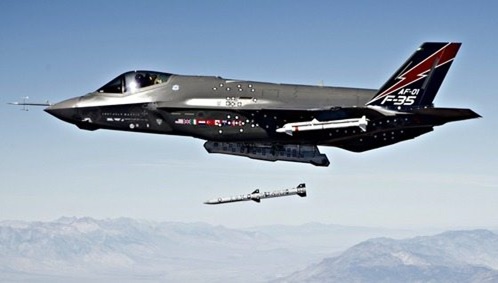
AIM-120 Missile Advanced Features
The AIM-120 AMRAAM is one of the world’s most sophisticated, combat-proven air superiority air-to-air weapon systems. It is a highly refined product with more than 30 years of design, upgrades, testing, and production efforts.
The AIM-120 missile continues to be the preferred aerial combat weapon of choice for many air forces across the globe. Its combat performance and kill capabilities have been fully demonstrated in over 4,900 test shots and combat victories scored during actual aerial engagements in armed conflicts.
AMRAAM Missile Features
- Beyond visual range capability: The AMRAAM has a range of up to 100 miles (160 km) and can engage targets beyond the pilot’s visual range, thanks to its active radar seeker and inertial guidance system.
- Highly accurate: The missile has a high degree of accuracy, thanks to its advanced guidance system and mid-course updates from the launching aircraft or other sources.
- Reliability: The AMRAAM has a very high reliability rate and has proven to be a very dependable missile system in combat.
- Interoperability: The missile can be integrated with a wide range of aircraft and weapon systems, making it a versatile and flexible weapon in air-to-air combat.
- Combat record: The AMRAAM has been used in combat by the United States and several of its allies, including in conflicts such as the Gulf War, Operation Allied Force over Kosovo, and Operation Inherent Resolve in Syria and Iraq. The missile has a high success rate in engagements against enemy aircraft, including the downing of several enemy aircraft.
AIM-120 Missile Advanced Seeker
The AIM-120 Advanced Medium-Range Air-to-Air Missile (AMRAAM) features an advanced active radar seeker that allows the missile to track and engage targets beyond the pilot’s visual range. The seeker uses a combination of radar signals and onboard computer processing to detect and track targets, even in highly cluttered and challenging environments. The missile’s seeker is also designed to be highly resistant to countermeasures, such as electronic jamming, making it a highly effective weapon system in air-to-air combat.
The seeker on the AIM-120 AMRAAM is a key component of its overall performance and capabilities. It enables the missile to engage targets with a high degree of accuracy and reliability, even in challenging conditions. The missile’s seeker also allows it to engage a wide range of targets, including enemy aircraft, unmanned aerial vehicles (UAVs), and cruise missiles, making it a highly versatile and flexible weapon system.
The advanced seeker on the AIM-120 AMRAAM is a critical component of its capabilities and performance in air-to-air combat. It allows the missile to engage targets beyond the pilot’s visual range with a high degree of accuracy and reliability, making it one of the most advanced and effective air-to-air missiles in the world.
AMRAAM Development History
The US Air Force sensed the necessity for a long-range air dominance weapon system due to fast developments in fighter jet technology. The AMRAAM missile project is a collaboration between the United States and NATO countries.
It was created as a result of an agreement between the United States and many other NATO countries to develop air-to-air missiles and share production technologies.
According to this agreement, the United States was tasked with creating the next generation medium-range missile (AMRAAM) with beyond visual range (BVR) capability with a range of up to 120 km.
Europe, on the other hand, assigned to build the next generation short-range missile (ASRAAM) with a range of up to 60 kilometres.
Despite its initial integration into European fighter jets, the UK’s Ministry Of Defence started a project to develop the Meteor missile, which eventually became a serious competitor to AMRAAM.
The AMRAAM project met its objectives and finished in December 1981 with a successful launch demonstration of flight testing. Hughes Aircraft’s Missile System Group was chosen as the missile’s full-scale development.
Raytheon was later picked as a successor manufacturer. Both companies were given the AIM-120 manufacturing contract in 1987. During the development phase flight tests, more than 200 missiles were fired to validate the missile performance.
Following that, other variations of the AMRAAM were developed, incorporating more advanced technology and offering very long-range BVR capability.
AMRAAM Variants
As of now, AMRAAM have been manufactured in four variants.
AIM-120A And AIM-120B Variants
The AIM-120A was the first variant, and this variant is no longer in service or production. The AIM-120B was the next improved variant introduced in 1994, and it is being phased out. The AIM-120A and AIM-120B models have reached the end of their service life.
AIM-120C Variant
The AIM-120C variant was specifically designed for the F22 Raptor. It has smaller control surfaces to enable internal carriage on the F/A-22 aircraft and carries an improved warhead. The AIM-120C was further upgraded to create a new variant called the AIM-120C-7, which was successfully tested in 2003.
AIM-120D Variant
The AMRAAM AIM-120D is the newest member of the family. In May 2009, the version completed its seventh test flight, integrating updated hardware and software capabilities for increased navigation, range, and HOBS (High-Angle Off-Boresight) performance.
The AIM-120D variant’s Follow-On Operational Test and Evaluation FOT&E was completed successfully in July 2014. By October 2014, the US Air Force and Navy had received a total of 1,031 AIM-120D missiles.
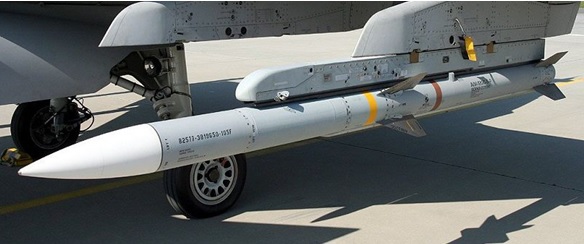
AIM-120ER Variant
AIM-120 ER Extended Range Variant
The AIM-120 ER AMRAAM-Extended Range Missile is the latest variant specially designed for ground-launched air defense solutions to intercept targets at longer distances and higher altitudes.
The AMRAAM-ER missile managed to achieve the extended range due to the integration of Raytheon’s Evolved Sea Sparrow missile ESSM® missile rocket motor and smarter flight control algorithms.
The AMRAAM-ER missile has been designed specifically for ground-based air defense systems; it will be integrated into the NASAMS launcher to further enhance air defense protection for long-distance engagements.
AIM-120D-3
Latest AMRAAM Variant AIM-120D-3
The U.S. Air Force has initiated the process to induct the latest variant of the AMRAAM missile system, AIM-120D-3. The missile has recently gone through and completed the Functional Configuration Audit (FCA) conducted by the US Air Force.
The latest variant of the AMRAAM, developed by Raytheon Technologies, will incorporate major improvements in terms of improved range, advanced seeker, and software improvements. The Advanced AIM-120D-3 Medium Range Air-to-Air Missile is likely to be inducted on operational platforms by the US Air Force and Navy.

The AIM-120D-3 incorporates the latest features, such as improved hardware, including 15 upgraded circuit cards developed with model-based systems engineering initiatives under the Form, Fit, Function Refresh program, and uses the latest System Improvement Program-3F software.
The AIM-120D-3 variant offers major fire and forget capabilities designed to counter both current and future threats. The missile software has also incorporated some major updates using the latest AI features. The AMRAAM system has been integrated on 14 platforms in 42 countries.
Fighters Jets And Countries That Operate AMRAAM Missile
The AIM-120 AMRAAM missile is a popular air-to-air missile used by several countries around the world. Please note that this is not an exhaustive list, and other countries and aircraft may also use the AIM-120 missile.
Some of the fighter aircraft that are known to be equipped with the AIM-120 include:
- United States: F-15 Eagle, F-16 Fighting Falcon, F/A-18 Hornet, F/A-18E/F Super Hornet, F-22 Raptor, and F-35 Lightning II.
- Canada: CF-18 Hornet
- Germany: Eurofighter Typhoon
- United Kingdom: Eurofighter Typhoon
- Italy: Eurofighter Typhoon
- Spain: Eurofighter Typhoon
- Saudi Arabia: F-15 Eagle
- South Korea: F-15 Eagle, F-16 Fighting Falcon
- Japan: F-2 fighter, F-15 Eagle
AMRAAM Vs Meteor Missile
The AMRAAM (Advanced Medium-Range Air-to-Air Missile) and the Meteor missile are both beyond-visual-range air-to-air missiles used by various countries’ militaries.
Here are some key differences between the two missiles:
Missile Feature | AMRAAM Missile | Meteor Missile |
Missile Picture |  | 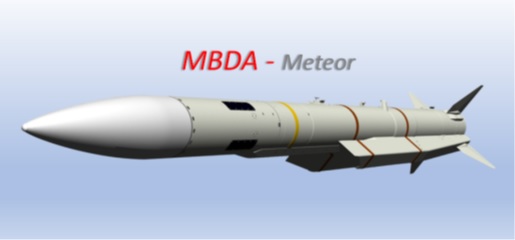 |
Maximum Range | 100 Km Plus | 120 Km Plus |
Top Missile Speed | Mach 4 | Mach 4 |
Manufactured By | Raytheon | MBDA |
Manoeuvrability | High | Very High |
Missile Warhead | Blast-Fragmentation, High-Explosive | Blast-Fragmentation, High-Explosive |
Guidence | Active Radar | Active Radar + Two-Way Datalink |
Missile Type | Air-To-Air , Beyond Visual Range, BVR Missile | Air-To-Air , Beyond Visual Range, BVR Missile |
Integration | Widespread | Limited |
Missile Unit Cost | US$1,090,000 (AIM-120D FY 2019) | €2,000,000 (2019) |
Production | Multiple Countries | Joint European Production |
Propulsion | Solid Rocket Motor | Ramjet Propulsion Engine |
Year Of Service Entry | 1991 | 2014 |


